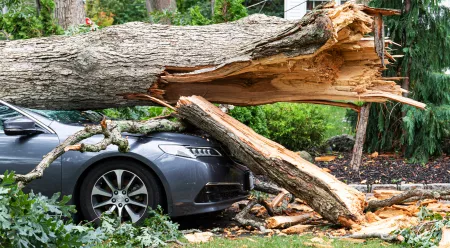Car accidents can be one of the most stressful situations a person finds themselves in. Canada has about 160,000 car accidents a year, with more than 2800 fatalities. The danger associated with car accidents makes them a situation no Ontario driver wants to experience.
Another source of stress comes from the issues that arise after an accident. Tickets, damages, and insurance rates going up are all factors that terrify Ontario drivers. Tickets are best controlled by driving safely. Damage to yourself and your vehicle is generally covered by your insurance. What about insurance? How much does your car insurance go up after an accident in Ontario?
The first thing to remember is to always drive safely. Most of what we discuss in this article is dependent on you driving safely and not taking unnecessary risks. Also, we cannot know the specifics of how your insurance company interprets your accident and the attendant accident forgiveness. We know that the difference between at-fault accident insurance increases and not at-fault insurance increases in Ontario is a complex one, and we’re here to help you understand the difference. Learn more about how long an accident will stay on your record.
Ontario’s No-fault Framework
Ontario operates under a no-fault insurance framework. This doesn’t mean that no one can be determined to be at-fault in an accident, it just means that both parties can still receive medical care and rehabilitation, even if one party is more at-fault than another.
This is to ensure that at the very least, Ontarians are cared for by their insurance in the difficult situation of a car accident. It’s important to remember that even though this framework doesn’t determine fault the same way some other systems do, the concept of fault is still very much a part of determining your insurance rates.
Insurance Rates
Your rates are set by your insurance company. Those rates are calculated based on a variety of factors such as age, driving history, location, what vehicle you’re ensuring, and the level of coverage.
These rates are subject to change. Generally, they follow a trend of being lower if you demonstrate a pattern of safe driving and no accidents or criminal charges relating to driving. If you demonstrate a pattern of at-fault accidents and other unsafe driving habits, your rates will likely increase, to cover the insurance company’s liability in covering you and your vehicle.
Why Fault Matters
There is a complex system in Ontario to determine how much your car insurance will go up after an accident, which is just one of many consequences you'll experience. It is administered by your insurance company after any sort of accident. The formula they use, and how they use it can be confusing to a layperson. We strongly recommend staying in communication with your insurance company after an accident and making sure they get the whole truth of the situation.
The cutoff percentage for how at-fault you would have to be for an accident to affect your insurance is 25%. Essentially, if your insurance company determines that you were less than 25% responsible for an accident, your premium cannot be increased. The specifics of how your insurance company determines fault are very complex, and not usually accessible to you as a driver. Your responsibilities should be much more straightforward. Your insurance company will do an investigation and let you know what information they need from you. Fault also matters from the perspective of liability. If you cause an accident, an injured party may decide to pursue you for damages. .
Accident Forgiveness Ontario
There is a three-year grace period for accidents in Ontario when it comes to insurance. Basically, if you have an accident that qualifies as minor, and is your first accident in 3 years, your insurance premium cannot be increased. This is fairly new, so don’t expect every driver on the road to fully understand this. This is what’s known as accident forgiveness in Ontario.
The accident also has to be a ‘minor’ accident, meaning that no one was injured, damages to the vehicles were less than 2000 dollars, and the at-fault driver paid all of the cost of damages, not the insurer.
There are some fairly specific situations when this applies or doesn’t. We would suggest that you talk to your insurance company to find out those specific criteria, and if your recent accident qualifies under accident forgiveness in Ontario. If your accident doesn’t qualify as a minor one, you might still be in good shape. Generally, rate increases are based on the likelihood of another accident. If you have a major accident, and it’s your first accident in a long time (think longer than 5-10 years) your increase for an at-fault accident might be a small one.
However, if you’ve had a major accident, and it’s not your first one in the recent timespan we’ve mentioned, your rate might see a serious increase for an at-fault accident. If you’re charged with a crime as a result of these accidents, your rate will suffer even more. Essentially, our earlier advice of driving as safely as possible always applies.
If you accumulate enough major accidents or criminal charges, you may have to receive a special high-risk level of insurance coverage. Since insurance companies who offer this type of coverage expect the likelihood of you being involved in another unsafe driving situation is high, you can expect your insurance rate to be very high indeed.
A great place to start is Surex’s Auto Insurance page. Surex can help you to understand your insurance rates, your coverage, and how that could be affected by a collision.
Accident Checklist
The first thing always is to make sure everyone’s safe. For minor fender benders, just make sure no-one is hurt. Check on the other driver safely and calmly. You’ll want to exchange insurance information with the other driver. In an emergency, dial 911. Otherwise, call your local police non-emergency number to alert them to the collision.
Once you’re sure you’re safe and you’ve contacted the appropriate emergency services, let your insurance company know what has happened. Letting your insurance know is an important step. They’ll work with you to investigate the accident and let you know what the next steps are. Give them your full and complete cooperation.



